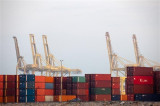World economic picture sees bright colours
In the recently released World Economic Outlook (WEO) report, the International Monetary Fund (IMF) lowered the 2023 economic growth forecast, for many economies around the world. Only a few economies, including the US, Japan, India and Russia, go against this trend. Positive signals from some economies are expected to contribute to brightening the global economic picture.
IMF forecasts that the US economy will grow by 2.1% in 2023 and 1.5% in 2024, up 0.3 percentage and 0.5 percentage points respectively, compared to the July forecast. Among developed economies, the US economy sees a clear gap compared to the Eurozone, as this area only grows by 0.7% in 2023 and 1.2% in 2024.
According to IMF chief economist Pierre-Olivier Gourinchas, there are many reasons for widening the gap between the economies on two sides of the Atlantic, but the leading cause is the conflict in Ukraine. Unlike the Eurozone, the US is a net energy exporter, so it gains more profits when energy prices rise. In addition, consumer spending in the US is more stable, and less affected by interest rate increases, due to higher long-term mortgage debts and more “generous” financial support measures during the COVID-19 period.
The US economy is expected to avoid a recession thanks to a stable labour market and moderate wage pressure. US Treasury Secretary Janet Yellen expressed her hope that the US economy will have a “soft landing”, both restraining inflation and avoiding recession, despite new risks arising, such as the conflict between the Hamas movement and Israel.
Also in the G7 group, the IMF has significantly raised its Japanese economic growth forecast to 2% in 2023, thanks to increased revenue from domestic and international tourism, along with adaptive policies, as well as the recovery in automobile export activities. In South Asia, India is considered to have good prospects among emerging markets and developing economies, with a forecast of 6.3% growth in 2023.
Notably, the Russian economy is much more resilient than many economists predicted. The IMF raised its growth forecast for this economy to 2.2% in 2023, an increase of 0.7 percentage points, compared to the July forecast. According to the IMF, this is due to the Russian Government’s measures on fiscal stimulus, strong investment and stable consumption. The IMF forecasts Russia’s fiscal deficit at 3.7% in 2023, up against the 2022 level, but significantly down from the July forecast.
This is partly due to better-than-expected tax collections and increased oil and gas revenues, as the ruble depreciates. Russian President Vladimir Putin also affirmed that the country’s economy is stable despite Western sanctions. The real income of Russians has expanded by more than 12%, while the income of people in Europe has declined.
According to the Russian President, Russia’s GDP has reached the same level as in 2021, with many key indicators of the economy performing better than expectations. Russia’s GDP was forecast to plunge this year but has been revised to a 1.2% growth. However, the Russian President also admitted the country’s economic problems, such as labour shortages and inflation.
With the Ukrainian economy, which has been seriously affected by the conflict, the IMF has a more positive assessment, raising its growth forecast for 2023 to 2% and expecting an increase of 3.2% in 2024. This is a positive signal because in its July report, the IMF forecast that Ukraine’s economy would reduce by 3% in 2023. Ukraine’s economic outlook has improved thanks to stronger-than-expected domestic demand, as businesses and Ukrainian households have adapted to the conflict, while inflation has subsided and the foreign exchange market has stabilised.
Despite the strong impact of the COVID-19 epidemic and conflicts, the global economy has shown remarkable resilience, continuing to recover after the pandemic and overcoming the effects of the conflict in Ukraine and the cost of living crisis, according to the IMF. The world economy continues to face many risks, but positive signals from major economies are the driving force for countries to maintain measures to curb inflation and introduce economic stimulus packages to foster growth.
NDO
 Nearly 200 terror suspects arrested in Indonesia in two years
Nearly 200 terror suspects arrested in Indonesia in two years
 Vietravel launches tourism joint venture in India
Vietravel launches tourism joint venture in India
 Vietnam willing to enhance int'l cooperation in transnational crime combat
Vietnam willing to enhance int'l cooperation in transnational crime combat
WB approves 750 mln USD loan to boost Philippines' digital transformation
 Promoting unity in the Middle East region
Promoting unity in the Middle East region
 Thailand strives to meet water demand in Eastern Economic Corridor
Thailand strives to meet water demand in Eastern Economic Corridor
 Indonesia’s Mount Lewotobi Laki-Laki erupts again
Indonesia’s Mount Lewotobi Laki-Laki erupts again
 Efforts to prevent the migration wave across Channel Tunnel
Efforts to prevent the migration wave across Channel Tunnel
 Thailand, Turkey agree to resume FTA negotiations
Thailand, Turkey agree to resume FTA negotiations
 Thailand eyes sending more workers to Singapore
Thailand eyes sending more workers to Singapore





